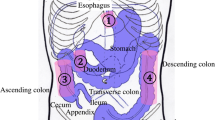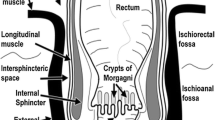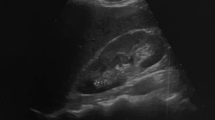Abstract
Purpose
To assess unenhanced magnetic resonance imaging (MRI) in the preoperative evaluation of obstructive epiphora in patients undergoing dacryocystorhinostomy (DCR) and in particular, to evaluate the efficacy of this technique in the detection of the exact level of obstruction occurring in the naso-lachrymal duct (NLD). The correct identification and characterization of the NLD and its obstructions lead to a more effective surgery, preventing recurrent dacryocystitis after the surgical treatment.
Methods
From January 2009 to December 2014, 127 obstructive epiphoras were diagnosed and treated in 127 patients (35 M, 92 F; mean age 60.7 ± 7.48 years, range 42–75 years) with endoscopic DCR, in a IRB-approved protocol. To precisely define the morphology of the NLD and the site of obstruction, some of these patients (67/127) underwent unenhanced 1.5-T MR with TrueFISP and VIBE sequences, while the remaining (60/127) underwent Gadolinium-enhanced 1.5-T MR. Afterwards, surgery checked the real site of obstruction in both groups of patients (enhanced and unenhanced MR), with surgical outcomes matched with previous MR reports.
Results
In all cases, unenhanced MRI was able to detect the exact site of obstruction along the NLD, allowing a correct planning of surgical endoscopic procedures. On the contrary, enhanced MRI wrongly diagnosed six patients with proximal stenosis (6/60, 10.0%) as intermediate NLD obstruction. Unenhanced MRI was found to be more accurate than enhanced MRI with a statistical significant difference (p value = 0.0256) and obviously cheaper and easier to perform. All imaging reports were verified with surgery. The correct identification of the level of obstruction allowed successful surgery in around 73% (93/127) of patients, who had no recurrence during 6-month follow-up.
Conclusion
In patients with epiphora, unenhanced MR showed to be highly reliable and even more effective than enhanced MR in the preoperative characterization of NLD stenosis, with no need of performing complex, time-wasting and expensive procedures for the administration of topical contrast media.




Similar content being viewed by others
References
Choi CJ, Jin HR, Moon YE et al (2009) The surgical outcome of endoscopic dacryocystorhinostomy according to the obstruction levels of lacrimal drainage system. Clin Exp Otorhinolaryngol 2:141–144
Christensen AL, Hansen PO, Jørgensen BG, Autzen T (2013) Endoscopic dacryocystorhinostomy seems promising for lacrimal stenosis. Dan Med J 60(2):A4581
Tarbet KJ, Custer PL (1995) External dacryocystorhinostomy. Surgical success, patient satisfaction and economic cost. Ophthalmology 102:1065–1070
Preechawai P (2012) Results of nonendoscopic endonasal dacryocystorhinostomy. Clin Ophtalmol 6(1):1297–1301
Serifoglu A, Karakurt A (1988) Can. Secondary dacryocystorhinostomy in cases of unsuccessful lacrimal surgery. Turkish J Ophtalmol 18:573–579
Manfrè L, de Maria M, Todaro E, Mangiameli A, Ponte F, Lagalla R (2000) MR dacryocystography: comparison with dacryocystography and CT dacryocystography. AJNR Am J Neuroradiol 21(6):1145–1150
Dutton JJ (1988) Diagnostic tests and imaging techniques. In: Linberg JV (ed) Lacrimal surgery. Churchill Livingstone, New York, pp 19–48
Glatt HJ, Chan CA, Barrett L (1991) Evaluation of dacryocystorhinostomy failure with computed tomography and computed tomographic dacryocystography. Am J Ophthalmol 112:431–433
Ashenhurst M, Jaffer N, Hurwitz JJ, Corin SM (1991) Combined computed tomography and dacryocystography for complex lacrimal problems. Can J Ophthalmol 26:27–31
Gmelin E, Rinast E, Bastian GO et al (1987) Dacryocystography and sialography with digital subtraction. Rofo 146:643–646
Hahnel S, Jansen O, Zake S, Sartor K (1995) Spiral CT in the diagnosis of stenoses of the nasolacrimal duct system. Rofo 163:210–214
Robertson JS, Brown ML, Colvard DM (1979) Radiation absorbed dose to the lens in dacryoscintigraphy with 99TcO4. Radiology 133:747–750
Rubin PA, Bilyk JR, Shore JW, Sutula FC, Cheng HM (1994) Magnetic resonance imaging of the lacrimal drainage system. Ophthalmology 101(2):235–243
Zinreich SJ, Miller NR, Freeman LE et al (1990) Computed tomographic dacryocystography using topical contrast media for lacrimal system visualization. Orbit 9:19–87
Karen S, Caldemeyer L, Stephan M et al (1998) Topical contrast-enhanced CT and MR dacryocystography: imaging the lacrimal drainage apparatus of healthy volunteers. AJR Am J Radiol 171:1501–1504
Goldberg RA, Heinz GW, Chiu L (1993) Gadolinium magnetic resonance imaging dacryocystography. Am J Ophthalmol 115:738–741
Busse H, Muller KM, Kroll P (1980) Radiological and histological findings of the lacrimal passages of newborns. Arch Ophthalmol 98:528
Lindberg JV (1983) Disorders of the lower excretory system. In: Milder B, Weil B (eds) The lacrimal system. Appleton-Century-Crofts, Norwalk, pp 133–143
Caranci F, Cicala D, Cappabianca S, Briganti F, Brunese L, Fonio P (2012) Orbital fractures: role of imaging. Semin Ultrasound CT MR 33(5):385–391
Cappabianca S, Colella G, Pezzulo MG et al (2008) Lipomatous lesions of the head and neck region: imaging findings in comparison with histological type. Radiol Med 113(5):758–770
Agarwal ML (1961) Dacryocystography in chronic dacryocystitis. Am J Ophtalmol 52:245
Ewing AE (1909) Roentgen ray demonstration of the lacrimal abscess cavity. Am J Ophthalmol 24:1
Hornblass A, Gabry JB (1980) Diagnosis and treatment of lacrimal sac cysts. Ophthalmology 86:1655
Veirs ER (1957) Stenosis of the canaliculus following irradiation therapy. Am J Ophthalmol 44:249
Patrinely JR, Gigantelli JW (1988) Dacryocystorhinostomy. In: Linberg JV (ed) Lacrimal surgery. Churchill-Livingstone, New York, pp 151–167
Linberg JV, McCormick SA (1986) Primary acquired nasolacrimal duct obstruction: a clinicopathologic report and biopsy technique. Ophthalmology 93:1055–1063
Mandeville JT, Woog JJ (2002) Obstruction of the lacrimal drainage system. Curr Opin Ophthalmol 13:303–309
Becker BB (2001) Recanalization of the obstructed nasolacrimal duct system. J Vasc Interv Radiol 12:697–699
Allen K, Berlin AJ (1989) Dacryocystorhinostomy failure: association with nasolacrimal silicone intubation. Ophthalmic Surg 20:486–489
Dryden RM, Wulc AE (1988) Surgery of the lacrimal system. In: Waltman SR, Keates RH, Hoyt CS (eds) Surgery of the eye. Churchill-Livingstone, New York, pp 607–628
Glatt HJ (1991) Dacryocystoplasty: an oculoplastic surgeon’s perspective (letter). Radiology 180:289–290
Ilgit E, Yuksel D, Unal M et al (1995) Transluminal balloon dilatation of the lacrimal drainage system for the treatment of epiphora. AJR Am J Roentgenol 165:1517–1524
Ilgit E, Önal B, Coskun B (2005) Interventional radiology in the lacrimal drainage system. Eur J Radiol 55:331–339
Song HY, Jin YH, Kim JH et al (1995) Nonsurgical placement of a nasolacrimal polyurethane stent. Radiology 194:233–237
Woog JJ, Kennedy RH, Custer PL et al (2001) Endonasal dacryocystorhinostomy. Am Acad Ophthal 108:2369–2377
Tsirbas A, Davis G, Wormald PJ (2005) Revision dacryocystorhinostomy: a comparison of endoscopic and external techniques. Am J Rhinol 19:322–325
El-Guindy A, Dorgham A, Ghoraba M (2000) Endoscopic revision surgery for recurrent epiphora occurring after external dacryocystorhinostomy. Ann Otol Rhinol Laryngol 109:425–430
Ari S, Kürşat Cingü A, Sahin A, Gün R, Kiniş V, Caça I (2012) Outcomes of revision external dacryocystorhinostomy and nasal intubation by bicanalicular silicone tubing under endonasal endoscopic guidance. Int J Ophthalmol 5(2):238–241
Mickelson SA, Kim DK, Stein IM (1997) Endoscopic laser-assisted dacryocystorhinostomy. Am J Otolaryngol 18:107–111
Metson R (1991) Endoscopic surgery for lacrimal obstruction. Otolaryngol Head Neck Surg 104:473–479
Puxeddu R, Nicolai P (2000) Endoscopic revision of failed external dacryocystorhinostomy. Acta Otorhinolaryngol Italy 20:1–4
Tanenbaum M, Mccord CD (1996) The lacrimal drainage system. In: Tasman W, Jaeger EA (eds) Duane’s clinical ophthalmology, revised edition. Lippincott Raven, Dunfermline, United Kingdom, pp 12–18
Fein W, Daykhovsky L, Papaioannu T et al (1992) Endoscopy of the lacrimal outflow system. Arch Ophthalmol 110:1748–1750
Singh AD, Singh A, Whitmore I, Taylor E (1992) Endoscopic visualization of the human nasolacrimal system: an experimental study. Br J Ophthalmol 76:663–667
Galloway JE, Kavic TA, Raflo GT (1984) Digital subtraction macrodacriocystography: a new method for lacrimal system imaging. Ophthalmology 91:956–962
Kassel EE, Schatz CJ (1995) Lacrimal apparatus. In: Som PM, Curtin HD (eds) Head and neck imaging, 3rd edn. Mosby-Year Book, St Louis, pp 1129–1183
Amanat LA, Hildtch TE, Kwok CS (1983) Lacrimal cyintigraphy. II. Its role in diagnosis of epiphora. Br J Ophthalmol 67:720–728
Takehara Y, Isoda H, Kurihashi K et al (2000) Dynamic MR dacryocystography: a new method for evaluating nasolacrimal duct obstructions. AJR Am J Roentgenol 175:469–473
Takehara Y, Kurihashi K, Isoda H et al (1998) Dynamic magnetic resonance dacryocystography using half Fourier single shot fast spin echo sequence. Nippon Igaku Hoshasen Gakkai Zasshi 58:524–526
Amrith S, Goh PS, Wang SC (2005) Tear flow dynamics in the human nasolacrimal ducts—a pilot study using dynamic magnetic resonance imaging. Graefes Arch Clin Exp Ophthalmol 243:127–131
Amrith S, Goh PS, Wang SC (2007) Lacrimal sac volume measurement during eyelid closure and opening. Clin Exp Ophthalmol 35:135–139
Coskun B, Ilgit E, Onal B, Konuk O, Erbas G (2012) MR dacryocystography in the evaluation of patients with obstructive epiphora treated by means of interventional radiologic procedures. AJNR Am J Neuroradiol 33(1):141–147
Cubuk R, Tasali N, Aydin S, Saydam B, Sengor T (2010) Dynamic MR dacryocystography in patients with epiphora. Eur J Radiol 73(2):230–233
Author information
Authors and Affiliations
Corresponding author
Ethics declarations
Conflict of interest
All authors declare that they have no conflict of interest in this manuscript.
Ethical approval
All procedures performed in studies involving human participants were in accordance with the ethical standards of the institutional and/or national research committee and with the 1964 Helsinki declaration and its later amendments or comparable ethical standards.
Informed consent
Informed consent was obtained from all individual participants included in the study.
Rights and permissions
About this article
Cite this article
Somma, F., d’Agostino, V., Tortora, F. et al. Magnetic resonance imaging in the pre-operative evaluation of obstructive epiphora: true-FISP and VIBE vs gadolinium. Radiol med 122, 123–130 (2017). https://doi.org/10.1007/s11547-016-0696-4
Received:
Accepted:
Published:
Issue Date:
DOI: https://doi.org/10.1007/s11547-016-0696-4




